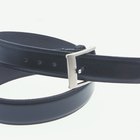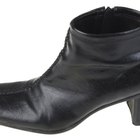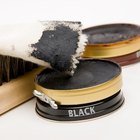If leather isn’t used or worked regularly, or properly stored, it will stiffen and become hard. This is especially true of leather cords, which can dry out more quickly because of its small size. Small pieces of leather are less able to retain moisture. Leather-softening applications can help speed up your leather-softening process, but you may want to avoid applications that contain solvents, which can weaken the leather’s fibers. Also, keep in mind that most applications will darken the leather to varying degrees.
Bend the cord, starting slowly and gently, up and down its entire length. Begin at one end of the cord, hold it between your fingers, and start flexing it back and forth. As you flex it, the stiffened fibers will start to loosen and become soft and pliable. Don’t force the cord too much, or you may crack its surface. Work it slowly, even if means taking several days to bring it to the level of softness you desire.
Rub a little oil into the cord if its “grain side,” or the smooth top side, shows signs of cracking or you need to soften it up more quickly. If the leather’s “flesh side” is visible, focus on rubbing oil into it. The flesh side is the rough side of the leather that used to be attached to the meat of the animal it came from. This side is porous and will absorb the oil readily, softening the leather’s fiber.
Allow the leather to dry after you have applied the oil. Alternatively, wipe any excess applications off the leather so it will dry more quickly. You can also wipe up any excess application if the leather cord feels greasy. Do not wash it off.
Flex the leather as much as you can, being careful not to crack the “grain side,” or the smooth top side, if you are concerned about its appearance. Work it slowly until it is as soft and pliable as you desire.
Related Articles

What Is a Good Way to Break In Danner ...

How to Repair Cracks in Leather Shoes & ...

How to Beeswax Leather

Making Leather Less Stiff

How to Glue a Leather Belt

How to Lacquer Leather

How to Soften a Boot Shaft That's Too ...

How to Care for Synthetic Leather

How to Care for Wet Leather

How to Break in a New Stiff Leather Belt

How to Recondition a Leather Coat

How to Repair a Wet Leather Jacket

How to Care for Nubuck Leather

How to Stretch the Calves on Leather ...

How to Waterproof a Leather Jacket

How to Make a Leather Jacket Softer

How to Get Sticker Residue Off of a ...

How Should I Protect My Lambskin ...

How to Identify Calfskin Leather

How to Restore Dried Out Shoe Polish on ...
References